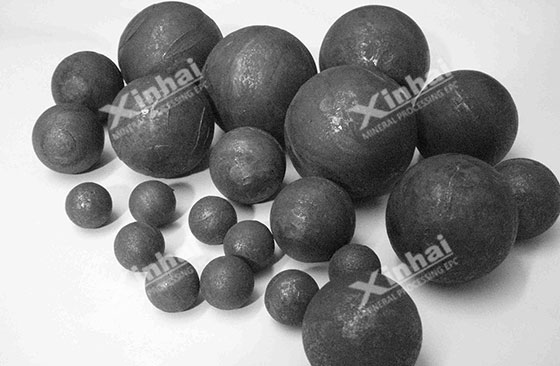
As one of the commonly used mineral processing equipment, the quantity and proportion of steel balls in ball mill barrel not only affect the grinding efficiency and production capacity of ball mill, but also affect the ball mill's service life.
In the operation process, grinding efficiency of ball mill generally depends on the sum of the work done by each steel ball (the number of steel ball impact and the impact force produced by steel ball). Therefore, to give full play to the crushing efficiency of each steel ball, it is necessary to ensure that steel balls moving along different trajectories do not collide as much as possible. When the steel balls in ball mill barrel are too much, the steel balls will overlap with each other, so that part of the steel balls cannot rise to the required height and then fall down, unable to give full play to crushing ability. At the same time, it also increases the kinetic energy consumption and shortens the service life of the ball mill. When the steel balls in the ball mill barrel are too small, the crushing capacity of each steel ball is maximized, but the overall crushing capacity is limited, thus affecting the grinding efficiency of ball mill.

Therefore, it is very important to keep the steel ball amount reasonable and balanced when using a ball mill. Then, in the ball mill running process, what is the most appropriate steel balls amount in ball mill barrel?
When the rotational speed of ball mill is fixed and the steel ball volume only accounts for 10% of the ball mill barrel volume, the steel ball in ball mill barrel is mainly in the form of sliding and there is no tilting flow. When the steel ball quantity gradually increases until 30%, the steel ball in the ball mill barrel is still mainly sliding, but the inclination flow phenomenon has begun to appear. When the steel ball quantity exceeds 40%, the steel ball in ball mill barrel will be mainly in the form of tilting flow. When the steel ball amount accounts for 50% of the total capacity of ball mill barrel, the steel ball surface is just on the diameter line of ball mill barrel, so it is easy to produce tilting flow, which is also the condition required for ball mill production. Therefore, it is appropriate to maintain the steel balls amount between one-third and one-half, and nearly one-half is the ideal.
According to the experimental results, when the steel ball filling amount in ball mill barrel is 40%, the ball mill output is highest, but in actual production, the steel ball filling rate in ball mill barrel is mostly around 35%, keeping the steel ball volume in barrel slightly lower than the horizontal center line of ball mill.

Now, we have known the best steel balls number to ensure the grinding efficiency and output of ball mill. In the actual mineral processing plant, after determining the appropriate steel balls number, we also need to choose the appropriate ball loading proportion, including the size of the ball, ball diameter series, the proportion of various specifications steel balls. Reasonable steel ball gradation is the key to maximize the grinding capacity of ball mill, which will directly affect the grinding efficiency and then affect the output of ball mill.
In the mineral processing plant, the more common steel ball gradation is two - grade and multigrade. In general, the multistage ratio follows the principle of less big and small steel balls and more intermediate steel balls, that is, less at both ends and more in the middle. The so-called two grade ratio is the use of two different specifications and diameter of larger ball to grade.

Usually, the gap between the large steel balls is filled with small steel balls to fully improve the steel balls density. Large steel ball can impact and crush the material, which greatly improves the impact capacity and impact times of ball mill. The small steel balls fill the gaps between large steel balls, improve the steel balls density, well control the flow rate of materials, at the same time, the coarse particle materials in the gap will be squeezed out in time, so that it can be placed in the impact zone of large steel balls.
However, if too many large steel balls in ball mill barrel will result in too coarse grinding particle size, that is called, "under grinding"; On the contrary, if there are too many small steel balls in ball mill barrel, the surface area will increase, resulting in the phenomenon of over-grinding. Moreover, due to too few large steel balls and insufficient impact strength, "over-grinding" and "under-grinding" will be caused. Therefore, the reasonable ball loading ratio can improve the grinding efficiency of the ball mill.

In a word, the number and proportion of steel balls is a relatively complicated technical problem. Every processing plant must carefully analyze the actual situation, through consulting professional ball mill manufacturers and long-term research and accumulation to find out the suitable amount. Be right for the purpose!
To find out more about our products and solutions, please fill out the form below and one of our experts will get back to you shortly.